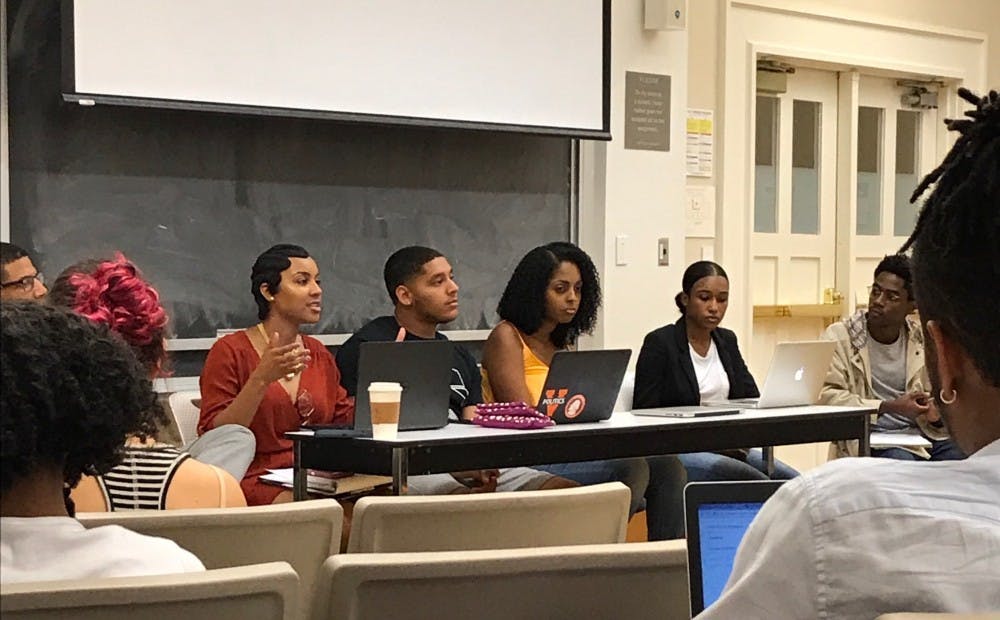The Black Student Alliance and several other student groups hosted a town hall Monday in Minor Hall for black students and allies from different communities across Grounds to come together, express concerns and discuss how they could better unite.
A panel composed of representatives from five student minority organizations — BSA, Organization of African Students, National Association for the Advancement of Colored People at U.Va., National Pan-Hellenic Council and the Ethiopian Eritrean Student Association — sat at the front of the room and led a discussion with students in the audience. There were a handful of students in attendance.
A large proportion of the town hall discussion focused on the importance of uniting the different organizations present. Some students had submitted questions anonymously beforehand, which were addressed during the meeting. One of the first asked was whether or not there was a “divide” between the BSA and the NAACP at U.Va.
Panel member Danyelle Honore’, a third-year College student and NAACP at U.Va. president, said she believed the notion of a divide between the two organizations is publicly misrepresented.
“We’re trying to work towards coming together and just being a stronger force together,” Honore’ said. “We haven’t had beef this year.”
Later in the dialogue, panel member Nana-Bilkisu Habib, a third-year College student and OAS secretary, was asked to name the most pressing issues for students to focus on.
“The problem I think we should tackle is increasing the amount of black students at U.Va., and why don’t they come,” Habib said. “We need to be reaching out to the dean and the admissions office and asking them — what are their criteria and why black people are not represented?”
The panel then brainstormed ideas for activities to get students involved with their organizations and to increase minority student enrollment. Honore’ suggested a personalized approach to trying to increase enrollment.
“Each black student can take some paper and write a letter to a prospective student and say ‘Hey, I would really like you to come,’” Honore’ said. “Sometimes that really makes a difference — personal stuff.”
Following concerns from students in the audience regarding the lack of visibility of the black culture at the University, the panel addressed ways in which they could create a greater social media presence. Going forward they want to begin using the hashtag #blackuva.
Naomi Yohannes, a third-year College student and EESA publicity officer, expressed her personal endeavours over summer to use social media to connect with newly accepted students.
“I made a point to try and reach out to people who have been admitted … And was like ‘Hey, black U.Va. students, I’m here, we’re here’ especially even after [Aug. 11 and Aug. 12],’” Yohannes said.
The panel also addressed the appointment of incoming University President James Ryan, a Harvard dean and University Law School graduate. While the panel generally made favorable comments towards him, they wanted to ensure that he tackles important issues once he takes office.
“I still think we should keep the momentum up,” Honore’ said. “I know that not everyone can make every event — not everyone is a protester, everyone has a different role — but I think we should keep the momentum up.”
Wes Gobar, a fourth-year College student and BSA president, said the BSA wants to start a dialogue with the new president in order to ensure their concerns are heard.
“It’s up to how he interacts with student leaders and moves forward,” Gobar said. “BSA will be sending a letter, with black concerns from our perspective and see how he responds to that.”
Following the town hall, Gobar said that he was very pleased with the event, and would be looking to hold more of them going forward.
“Last year, we didn’t have many town halls, and that’s where we were wrong. This was really good — it was really proactive,” Gobar said. “It was like, ‘Here’s what we’ve done so far. Let’s talk about your issues and concerns.’ I think it would be good to have a couple of these — like one or two per semester.”







